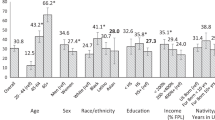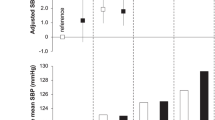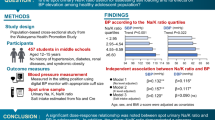Abstract
Studies of populations or communities with no rise in blood pressure (BP) with advancing age and low prevalence of hypertension, may provide aetiological clues on the cause of hypertension. Within westernised societies, low blood pressures have been reported amongst chronic psychiatric in-patients and closed order secluded nuns. To investigate factors associated with BP in chronic psychiatric in-patients, we surveyed the BP and lifestyle factors in 89 such subjects in low security wards in three psychiatric hospitals. The average age of examines was 48.1 years (s.d. 15.8) and the patients had been in hospital for a mean of 8.6 years (range 1.1 to 51.7 years). The mean systolic and diastolic blood pressures of this group were 122.0 mm Hg (s.d. 14.2) and 76.9 mm Hg (s.d. 8.5) respectively. This was lower than pressures obtained when they were admitted to hospital (mean systolic BP change −17.1 mm Hg (s.d. 14), paired t-test P < 0.001; mean diastolic bp change −3.7 mm hg (s.d. 12.2), paired t-test P < 0.001). bp at examination was significantly correlated with the urinary sodium to creatinine ratio (r = 0.302, P = 0.027), but not with the urinary sodium or potassium concentrations or potassium/creatinine ratio. The change in mean systolic BP (that is, the difference in BP between admission and examination) was significantly correlated with sodium/creatinine ratio (r = 0.62, P < 0.0001), urinary sodium concentration (r = 0.27, P = 0.045) and urinary sodium/potassium ratio (r = 0.36, P = 0.008). No relationship was found between BP and the nature of the psychiatric diagnosis or the type of psychotropic medication that was being prescribed. Stepwise multiple regression demonstrated that urinary sodium creatinine ratio and age were predictive of the change in systolic BP since admission to hospital. Our study confirms previous observations of lower mean systolic and diastolic blood pressures in chronic psychiatric subjects after a long in-patient stay. This fall is related to a low urine sodium excretion and suggests that a low dietary sodium intake may, in part, account for the low BP, or the difference between BP in the stressed and relaxed state, seen in these patients.
This is a preview of subscription content, access via your institution
Access options
Subscribe to this journal
Receive 12 digital issues and online access to articles
$119.00 per year
only $9.92 per issue
Buy this article
- Purchase on Springer Link
- Instant access to full article PDF
Prices may be subject to local taxes which are calculated during checkout
Similar content being viewed by others
Author information
Authors and Affiliations
Additional information
This paper was submitted and considered via the USA office of the Journal of Human Hypertension
Rights and permissions
About this article
Cite this article
Lip, G., Douglas, M., Gupta, A. et al. Urinary sodium excretion and blood pressure in chronic psychiatric in-patients. J Hum Hypertens 13, 461–466 (1999). https://doi.org/10.1038/sj.jhh.1000853
Received:
Revised:
Accepted:
Published:
Issue Date:
DOI: https://doi.org/10.1038/sj.jhh.1000853



